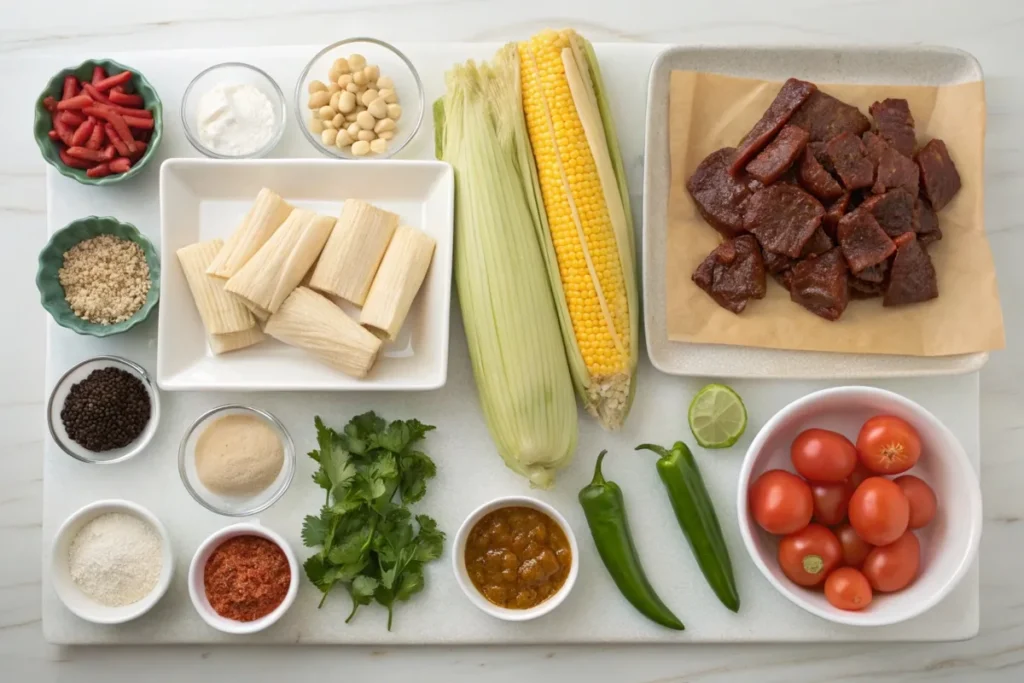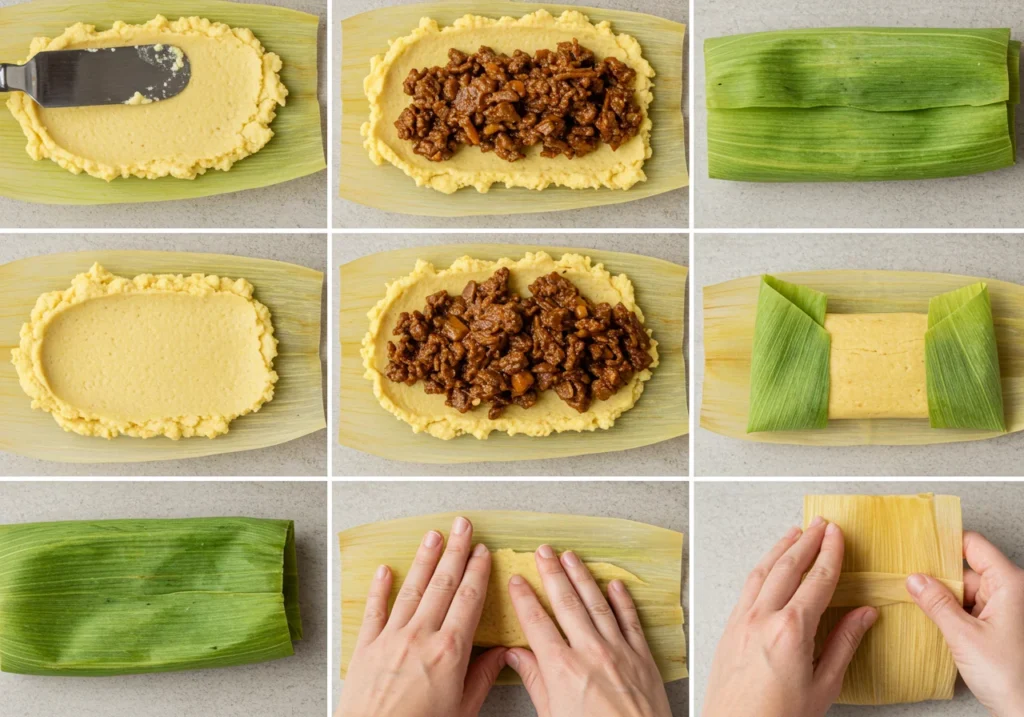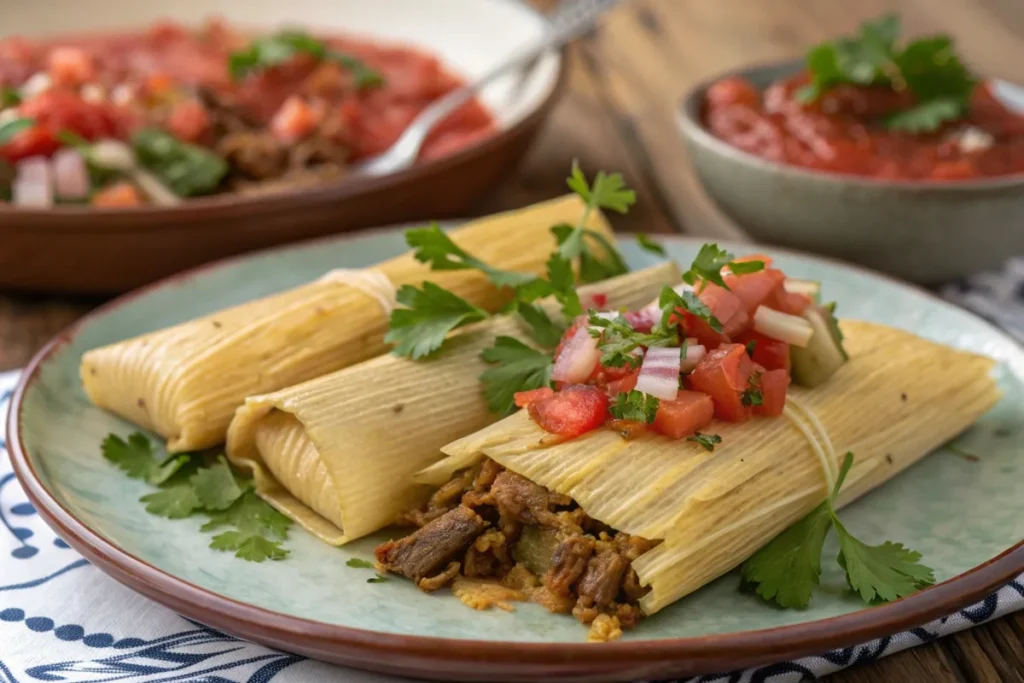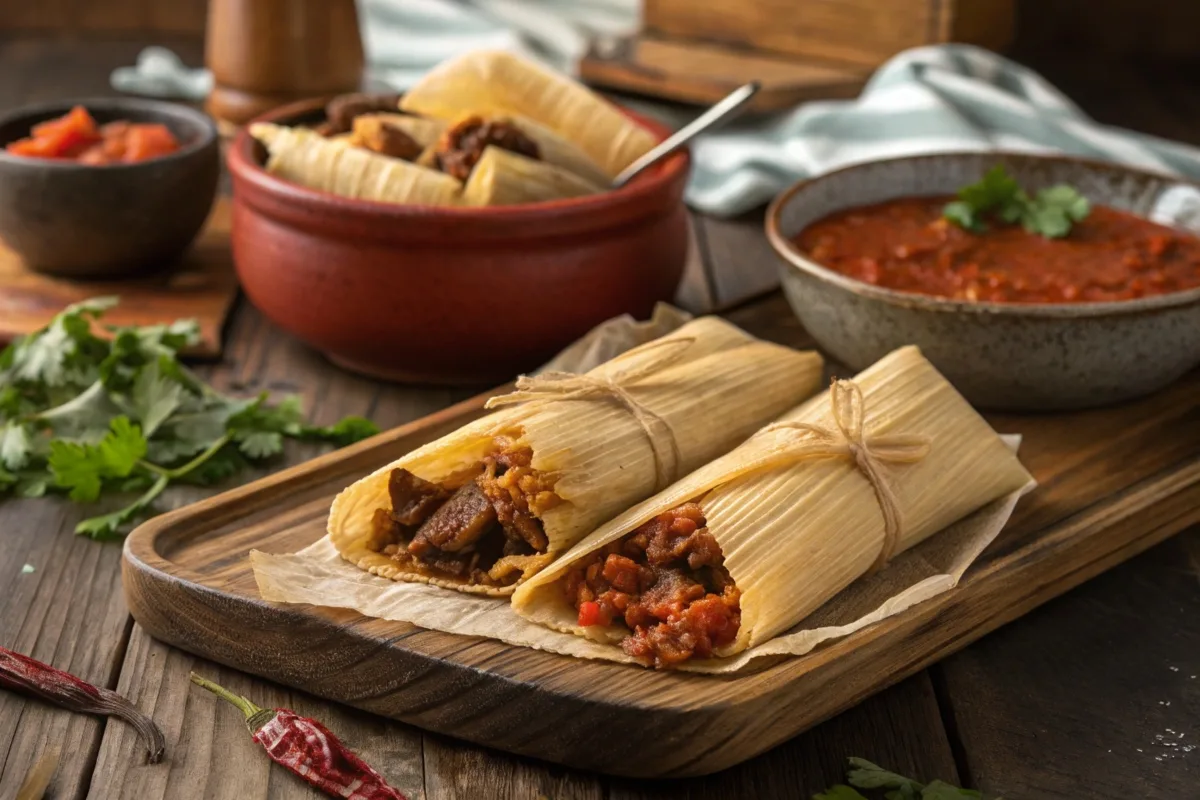Discover the rich ingredients and authentic preparation methods for delicious beef tamales in our comprehensive guide.
Introduction
Tamales hold a special place in many cultures, particularly within Mexican cuisine. These savory parcels of masa and filling, wrapped in corn husks or banana leaves, offer a delightful combination of textures and flavors. Among the various types of tamales, beef tamales stand out for their hearty and satisfying nature. This article delves deep into the world of beef tamales, exploring their history, essential ingredients, step-by-step preparation, regional variations, nutritional information, and expert tips to ensure your tamales are perfect every time.
Table of Contents
History and Cultural Significance of Tamales
Origins of Tamales
Tamales trace their roots back to ancient Mesoamerican civilizations, including the Aztecs and Mayans. These early cultures cherished tamales not only as a versatile food source but also for their symbolic significance. They often prepared tamales for special occasions, religious ceremonies, and as offerings to deities. The intricate process of making tamales fostered social bonds and preserved cultural traditions through communal activities.
Evolution of Tamales Over Time
Over centuries, tamales have evolved, adapting to various cultural influences and regional tastes. Spanish colonization introduced new ingredients and cooking techniques, enriching tamale recipes. As tamales spread across different regions, each area developed its unique variations, incorporating local flavors and ingredients. Today, tamales enjoy worldwide popularity, with each region adding its distinctive touch to this traditional dish.
Beef Tamales in Modern Cuisine
In contemporary cuisine, beef tamales have gained immense popularity, especially in the United States. People celebrate them for their robust flavors and versatility, making them a favorite during holidays, festivals, and family gatherings. Regional variations in the U.S. reflect diverse cultural influences, from Tex-Mex to Southwestern styles, each offering a unique twist on the classic beef tamale.
For an authentic experience, try our Traditional Beef Tamales Recipe that has been cherished through generations.
Essential Ingredients of Beef Tamales

Masa (Dough) Components
The foundation of any tamale is the masa, a dough made primarily from masa harina (corn flour) or fresh masa. Masa harina undergoes a treatment with lime, enhancing its flavor and texture. Fresh masa, often used in authentic recipes, provides a richer taste. Incorporating fat into the masa is crucial for achieving the right consistency and flavor. Traditional recipes use lard, but vegetable shortening or healthier alternatives like olive oil also work well. The masa must be smooth and pliable, ensuring it envelops the filling perfectly.
Beef Filling
The beef filling forms the heart of beef tamales. Choosing the right cut of beef ensures tenderness and flavor. Cuts like brisket or chuck are ideal as they become tender when slow-cooked. Season a blend of spices, such as cumin, chili powder, garlic, and oregano, to infuse the meat with rich flavors. Slow-cooking the beef allows it to absorb the spices and become succulent, making every bite of the tamale delightful.
Additional Fillings and Enhancements
Beyond the beef, additional ingredients can enhance the tamale’s flavor and texture. Vegetables like bell peppers and onions add sweetness and crunch, while beans provide extra protein and fiber. Incorporating sauces—whether red, green, or mole—introduces depth and complexity to the filling. These enhancements make beef tamales more flavorful and satisfying.
Wrapping and Cooking Materials
Tamales traditionally wrap in corn husks or banana leaves. Corn husks are preferred for their subtle flavor and ease of use, while banana leaves impart a unique aroma and taste. Preparing the wrappers involves soaking them in warm water to make them pliable. Properly prepared wrappers ensure the tamales hold their shape during steaming and infuse the dough with additional flavors.
Optional Ingredients and Variations
To cater to diverse tastes and dietary preferences, optional ingredients like cheese, olives, or vegetables can be added to the filling. Vegetarian and vegan adaptations use plant-based proteins and vegetable-based fats, allowing everyone to enjoy delicious tamales. These variations expand the versatility of beef tamales, making them suitable for various occasions and preferences.
Step-by-Step Preparation of Beef Tamales
Preparing the Masa
Start by preparing the masa, ensuring it has the right consistency. If you use masa harina, mix it with warm water or broth, gradually adding fat until the dough is smooth and slightly sticky. For fresh masa, blend it until smooth before incorporating the fat. The masa should be light and fluffy, not too dense or dry.
Cooking the Beef Filling
Cooking the beef filling requires patience to achieve maximum tenderness and flavor. Begin by searing the beef to lock in juices and enhance flavor. Then, transfer the seared beef to a slow cooker or pot, adding spices, herbs, and sauce. Allow the beef to cook slowly, breaking it down into tender, flavorful pieces. This method ensures the beef absorbs all the seasonings, making the filling rich and satisfying.
Assembling the Tamales

Assembly is a crucial step that demands attention to detail. Soak the corn husks or banana leaves until pliable. Spread a generous amount of masa onto each wrapper, creating a thin, even layer. Add a spoonful of the beef filling in the center of the masa. Fold the sides of the wrapper towards the center and then fold the bottom up, ensuring the tamale is securely wrapped. Proper assembly prevents the tamales from falling apart during steaming.
Steaming the Tamales
Steaming is the final cooking step that brings all the flavors together. Arrange the assembled tamales upright in a steamer, ensuring they are tightly packed to prevent them from drying out. Steam the tamales for about 1.5 to 2 hours, checking occasionally to ensure they are cooked through. The masa should pull away from the husks easily, indicating that the tamales are ready.
Serving and Storing Tamales
Once steamed, let the tamales rest for a few minutes before unwrapping. Serve them warm, accompanied by your favorite salsa, guacamole, or a side of beans. Tamales can be stored in the refrigerator for up to a week or frozen for longer preservation. To reheat, steam them again or microwave with a damp paper towel to retain moisture.
To complement your beef tamales, consider preparing our Mexican Beef Stew: Authentic Flavors for a complete and hearty meal.
Variations and Regional Differences
Regional Beef Tamale Styles in Mexico
Mexico boasts a rich diversity of tamale styles, with each region offering its unique take on beef tamales. In the Yucatán, beef tamales often infuse achiote, giving them a distinct color and flavor. Northern regions might incorporate dried chilies and local spices, while coastal areas may add seafood or tropical ingredients, reflecting the local palate.
Beef Tamales Across the United States
In the United States, beef tamales have been embraced and adapted by various culinary traditions. Tex-Mex tamales often feature spicy beef fillings with jalapeños, while Southwestern styles might incorporate indigenous spices and ingredients. These regional adaptations highlight the versatility of beef tamales, making them a beloved dish across the country.
International Takes on Beef Tamales
Globally, tamales adapt to suit local tastes and ingredients. In countries like the Philippines, tamales include local spices and meats, while in the Caribbean, they feature tropical fruits and seafood. These international variations showcase the tamale’s adaptability and universal appeal.
Fusion and Modern Twists
Modern culinary trends introduce fusion and gourmet twists to traditional beef tamales. Chefs experiment with non-traditional ingredients like exotic cheeses, unique spices, and innovative fillings. These contemporary variations elevate tamales to gourmet status, appealing to food enthusiasts seeking new and exciting flavors.
Nutritional Information and Dietary Considerations
Basic Nutritional Profile
Beef tamales offer a balanced mix of macronutrients and essential vitamins. A typical beef tamale contains approximately 300 calories per serving, with a good balance of protein, carbohydrates, and fats. The protein from beef supports muscle growth and repair, while the carbohydrates from masa provide energy. Fats contribute to satiety and flavor.
Health Benefits of Ingredients
The ingredients in beef tamales offer various health benefits. Beef is a rich source of protein, iron, and B-vitamins, essential for energy metabolism and red blood cell formation. Masa harina provides complex carbohydrates and fiber, aiding in digestion. Vegetables added to the filling contribute vitamins, minerals, and antioxidants, enhancing the tamale’s nutritional value.
Dietary Modifications
For those with specific dietary needs, beef tamales can easily adapt. Ensure all ingredients are gluten-free by selecting appropriate masa harina. Use low-fat or plant-based alternatives to lard to reduce the fat content, making tamales healthier without compromising flavor. Additionally, choosing lean cuts of beef can lower the overall fat content.
Allergen Information
Common allergens in tamales include corn, dairy (if cheese is added), and occasionally soy or gluten (if non-traditional ingredients are used). To accommodate those with allergies, substitute with dairy-free cheese or gluten-free masa harina. Always check ingredient labels to ensure tamales are safe for those with specific allergies.
Nutritional Content (Per 100g)
| Nutrient | Amount |
|---|---|
| Calories | 250 kcal |
| Protein | 12g |
| Carbohydrates | 30g |
| Fat | 10g |
| Fiber | 3g |
| Vitamin A | 15% DV |
| Calcium | 10% DV |
| Iron | 20% DV |
Tips and Tricks for Perfecting Beef Tamales

Ensuring the Right Masa Consistency
Achieving the perfect masa consistency is crucial. The dough should be moist but not sticky, easily spreadable without tearing the wrappers. If the masa feels too dry, add a little broth or water. Conversely, if it’s too wet, incorporate more masa harina until you reach the desired texture.
Achieving Tender and Flavorful Beef
Selecting the right cut of beef and slow-cooking it ensures tenderness. Marinate the beef before cooking to enhance its flavor. Additionally, allowing the beef to rest after cooking helps retain its juices, making each bite succulent and flavorful.
Preventing Tamales from Falling Apart
Proper assembly is key to preventing tamales from falling apart. Ensure the masa layer is even and not too thick, and securely fold the wrappers around the filling. Avoid overfilling, which can cause tamales to tear during steaming.
Enhancing Flavor with Proper Seasoning
Seasoning plays a vital role in tamale flavor. Taste the beef filling before assembling to ensure it’s well-seasoned. Balance the spices to complement the beef without overpowering the masa. Fresh herbs like cilantro can add a burst of freshness.
Efficient Wrapping and Steaming Techniques
Efficient wrapping ensures tamales maintain their shape during steaming. Arrange the wrapped tamales snugly in the steamer, leaving space for steam circulation. Maintain a consistent steam level and avoid opening the steamer frequently to retain heat and moisture.
Common Mistakes and How to Avoid Them
Over or Under Cooking the Masa
Overcooking can make the masa dry and crumbly, while undercooking leaves it doughy. Follow the recipe’s steaming time guidelines and check for doneness by ensuring the masa pulls away from the husks easily.
Using the Wrong Cut of Beef
Using lean or tough cuts of beef can result in dry or chewy filling. Opt for cuts like brisket or chuck that become tender when slow-cooked, ensuring a juicy and flavorful filling.
Inadequate Seasoning and Flavoring
Insufficient seasoning can make tamales bland. Always taste the filling before assembling and adjust seasoning as needed. Incorporate a variety of spices and herbs to build depth of flavor.
Improper Wrapping Techniques
Poor wrapping can cause tamales to fall apart or lose shape. Ensure the masa and filling are evenly distributed and the wrappers are tightly folded. Practice makes perfect, so don’t be discouraged by initial attempts.
Storage and Reheating Errors
Improper storage can lead to spoilage or dry tamales. Store tamales in airtight containers in the refrigerator or freezer. When reheating, use steaming or microwaving with a damp paper towel to retain moisture.
Frequently Asked Questions (FAQ)
What are meat tamales made of?
Meat tamales typically consist of masa (corn dough) filled with seasoned meat, such as beef, pork, or chicken. The meat cooks slowly with spices and sauces to ensure tenderness and rich flavor, then wraps in corn husks or banana leaves and steams to perfection.
What are tamales traditionally made of?
Traditionally, tamales use masa harina (corn dough) filled with a variety of ingredients, including meats like pork or chicken, vegetables, cheeses, or even sweet fillings like fruits. They wrap in corn husks or banana leaves and steam, reflecting their deep cultural roots in Mesoamerican cuisine.
Are beef tamales healthy?
Beef tamales can be part of a balanced diet when prepared with lean beef and wholesome ingredients. They provide protein from the beef, carbohydrates from the masa, and essential vitamins and minerals from added vegetables. However, the nutritional value can vary based on ingredients and preparation methods.
What is the most common tamale filling?
The most common tamale filling varies by region, but pork is traditionally the most popular in many areas. However, beef, chicken, and cheese are also widely used. Vegetarian fillings with beans and vegetables are becoming increasingly popular as well.
Conclusion
Beef tamales are a delicious and versatile dish that embodies rich cultural traditions and flavors. From selecting the right ingredients to mastering the preparation and steaming process, making perfect beef tamales requires attention to detail and a passion for authentic cuisine. Whether you’re a seasoned cook or trying tamales for the first time, this guide provides all the information you need to create mouthwatering beef tamales that will delight your family and friends. Explore the diverse world of tamales and enjoy the satisfaction of crafting this timeless culinary treasure.

